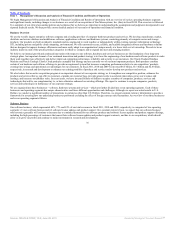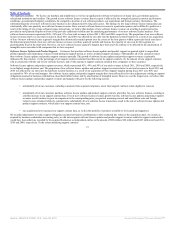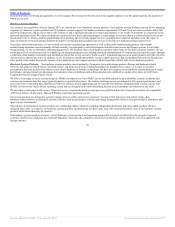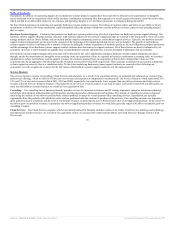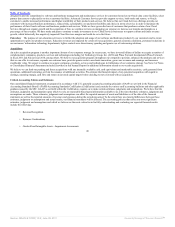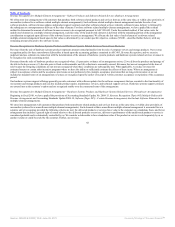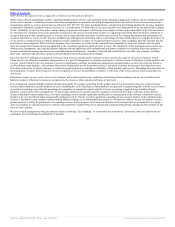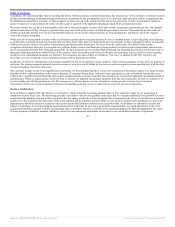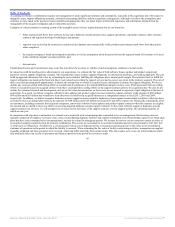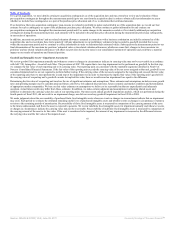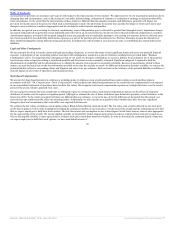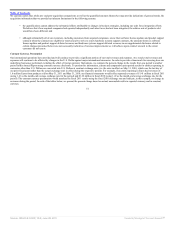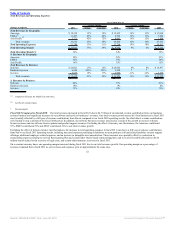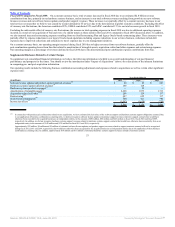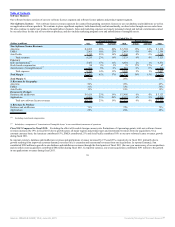Oracle 2010 Annual Report Download - page 49
Download and view the complete annual report
Please find page 49 of the 2010 Oracle annual report below. You can navigate through the pages in the report by either clicking on the pages listed below, or by using the keyword search tool below to find specific information within the annual report.
Table of Contents
cancellation. We consider multiple factors, including the history with the customer in similar transactions, the “essential use” of the software or hardware systems
products and the planning, budgeting and approval processes undertaken by the governmental entity. If we determine upon execution of these arrangements that
the likelihood of cancellation is remote, we then recognize revenues once all of the criteria described above have been met. If such a determination cannot be
made, revenues are recognized upon the earlier of cash receipt or approval of the applicable funding provision by the governmental entity.
We assess whether fees are fixed or determinable at the time of sale and recognize revenues if all other revenue recognition requirements are met. Our standard
payment terms are net 30 days. However, payment terms may vary based on the country in which the agreement is executed. Payments that are due within six
months are generally deemed to be fixed or determinable based on our successful collection history on such arrangements, and thereby satisfy the required
criteria for revenue recognition.
While most of our arrangements for sales within our businesses include short-term payment terms, we have a standard practice of providing long-term financing
to creditworthy customers through our financing division. Since fiscal 1989, when our financing division was formed, we have established a history of collection,
without concessions, on these receivables with payment terms that generally extend up to five years from the contract date. Provided all other revenue
recognition criteria have been met, we recognize new software license revenues and hardware systems products revenues for these arrangements upon delivery,
net of any payment discounts from financing transactions. We have generally sold receivables financed through our financing division on a non-recourse basis to
third party financing institutions within 90 days of the contracts’ dates of execution and we classify the proceeds from these sales as cash flows from operating
activities in our consolidated statements of cash flows. We account for the sales of these receivables as “true sales” as defined in ASC 860, Transfers and
Servicing, as we are considered to have surrendered control of these financing receivables.
In addition, we enter into arrangements with leasing companies for sale of our hardware systems products. These leasing companies, in turn, lease our products to
end-users. The leasing companies generally have no recourse to us in the event of default by the end-user and we recognize revenue upon delivery, if all the other
revenue recognition criteria have been met.
Our customers include several of our suppliers and occasionally, we have purchased goods or services for our operations from these vendors at or about the same
time that we have sold our products to these same companies (Concurrent Transactions). Software license agreements or sales of hardware systems that occur
within a three- month time period from the date we have purchased goods or services from that same customer are reviewed for appropriate accounting treatment
and disclosure. When we acquire goods or services from a customer, we negotiate the purchase separately from any sales transaction, at terms we consider to be
at arm’s length, and settle the purchase in cash. We recognize new software license revenues or hardware systems product revenues from Concurrent
Transactions if all of our revenue recognition criteria are met and the goods and services acquired are necessary for our current operations.
Business Combinations
In fiscal 2010, we adopted ASC 805, Business Combinations, which revised the accounting guidance that we were required to apply for our acquisitions in
comparison to prior fiscal years. The underlying principles are similar to the previous guidance and require that we recognize separately from goodwill the assets
acquired and the liabilities assumed at their acquisition date fair values. Goodwill as of the acquisition date is measured as the excess of consideration transferred
and the net of the acquisition date fair values of the assets acquired and the liabilities assumed. While we use our best estimates and assumptions as a part of the
purchase price allocation process to accurately value assets acquired and liabilities assumed at the acquisition date, our estimates are inherently uncertain and
subject to refinement. As a result, during the measurement period, which may be up to one year from the acquisition date, we record adjustments to the assets
acquired and liabilities assumed, with the corresponding offset to goodwill. Upon the conclusion of the measurement period or final determination of the values
of assets acquired or liabilities assumed, whichever comes first, any subsequent adjustments are recorded to our consolidated statements of operations.
45
Source: ORACLE CORP, 10-K, June 28, 2011 Powered by Morningstar® Document Research℠



